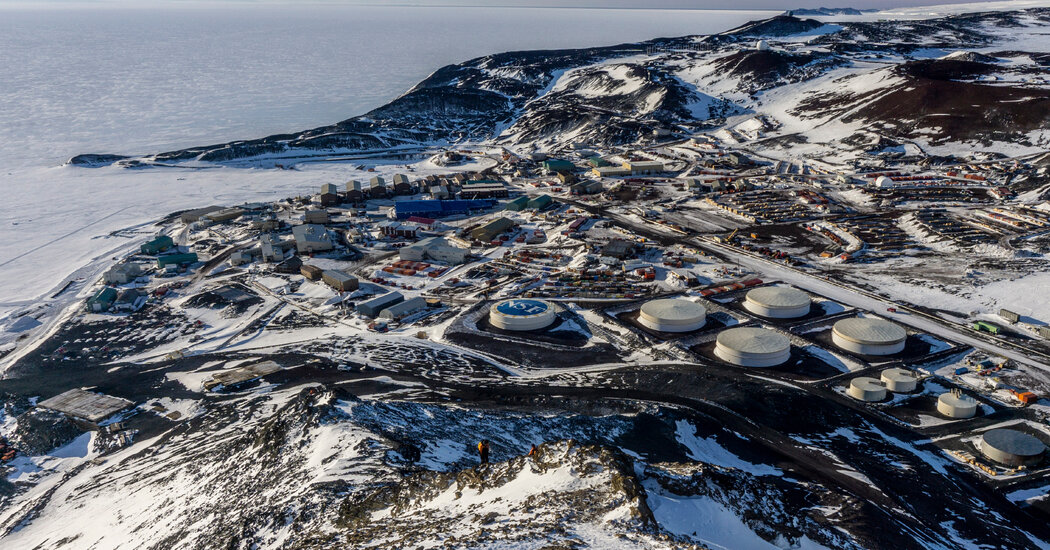Milan is about 10,000 miles, as the albatross flies, from McMurdo Station, the United States’ main outpost in Antarctica. But from late June to early July, representatives of 58 nations gathered in the Italian fashion capital for discussions about the remote continent’s present and future.
Difficult questions hung over the meeting: Will the southernmost continent remain a place for science and peace? Or will it become another object of territorial competition among great powers?
Antarctica is governed by the Antarctic Treaty, in force since 1961, stipulating that it is a refuge for peace and science, with military activity prohibited, and the environment protected. The document promotes international collaboration and lays aside the territorial claims of seven countries, which have all agreed not to act on their claimed ownership.
Ever since the treaty was signed, conflict has stayed farther north. “It was known as Antarctic exceptionalism,” said Jeffrey McGee, a law professor and Antarctic Treaty expert at the University of Tasmania.
Recently, though, that precedent has started to face strain. The world, Dr. McGee said, is turbulent, and its big players — the United States, Russia, China — are also the big players near the South Pole. “We’d be a little bit naïve to think that this isn’t going to affect the Antarctic Treaty system and the Antarctic region,” he added, referring to the dynamics that shape the rest of the world coming to Antarctica.
China and Russia are working on expansions to their own scientific facilities in Antarctica and some experts suspect the countries’ infrastructure could have nonpeaceful uses. And a committee of the British House of Commons has questioned the purpose of Russian seismic surveys, suggesting they represented potential oil prospecting, rather than scientific exploration. (China and Russia’s treaty representatives did not reply to emailed requests for comment).
With President Trump’s return to the White House, the United States’ approach to Antarctica may shift. The National Science Foundation — the primary agency that funds and oversees activities in both Antarctica and the Arctic — is proposing iceberg-size research cuts to polar science in 2026. Around 70 percent of the money currently in that pot for both poles could vanish.
Given that science and civilian presence are the primary ways America exerts power in Antarctica, pulling back on research leaves some treaty partners feeling nervous about the future.
In the 1950s, the United States brought together the original signatories of the Antarctic Treaty, and it has since been a leader in the region. It boasts the biggest research station and is the only country with a base at the geographic South Pole. “The United States has the largest presence in Antarctica,” said Bill Muntean, who was the head of the U.S. delegation to the Antarctic Treaty Consultative Meeting in 2022 and 2023, and is now with the Center for Strategic and International Studies.
But even before this most recent budget proposal, the United States was flagging in its investments. “The United States has been doing a steady retreat from activities in Antarctica,” Mr. Muntean said. “It’s not closing any stations, but it’s not repairing them or building them in an expeditious manner, and it has been reducing some of its logistics capacity.”
The National Science Foundation’s proposed 2026 budget includes further cuts to its Office of Polar Programs, which administers activities in the Antarctic under the United States Antarctic Program.
Those budget cuts, according to Mr. Muntean, demonstrate “that this administration considers science in the polar regions in the same level of interest as it does science in any other sort of area.”
Proposed cuts to infrastructure spending are less sharp than for research, but would delay planned upgrades and expansions to facilities and would decommission the last dedicated U.S. research ship for the continent. “That just slows down the whole entire scientific process,” said Joanne Padrón Carney, chief government relations officer for the American Association for the Advancement of Science, referring to research cuts.
Asked about the president’s budget proposal, Cassandra Eichner, a spokeswoman at the National Science Foundation, said in a statement that the agency remained committed to ensuring that the U.S. Antarctic Program “maintains an active and influential U.S. presence on the Antarctic continent that enables cutting-edge scientific research.”
The proposed spending don’t provide confidence in that scientific commitment, Mr. Muntean said. Geopolitically, he adds, they also send a worrying signal — because decreased presence means decreased influence, leaving a vacuum for other nations to fill.
“Over time, if China is rising and the U.S. is either standing still or decreasing its capabilities, then that will be read as China taking our place,” said Evan Bloom, an adviser for the Antarctic and Southern Ocean Coalition and a former State Department official who led the U.S. delegations to Antarctic treaty meetings from 2006 to 2020.
Mr. Muntean warned that a dip in federal science investments in the polar regions could mean that the N.S.F. is “not going to be the vehicle by which to respond to that growing competition.”
If scientific budgets fall as military budgets rise in the U.S. government, and that includes more defense-related ships allowed under the treaty, it could send a distinct signal abroad.
“While all types of vessels are welcome in the region so long as they are for peaceful purposes, increasing the number of military vessels while decreasing the number of scientific vessels gives the appearance of militarization of the region, which goes against long-term U.S. policy and interests,” Mr. Muntean said.
And in the policy legislation signed Friday by President Trump, a substantial sum was set aside for polar security cutters.
Abroad, other countries are worried about a U.S. pullback — in part for political reasons, and in part because they work with the United States on scientific research. Dr. McGee said Australians were watching the U.S. budget proposals and their implications warily.
The dynamics, absent this upset, were already shifting. Observers were worried about whether China’s and Russia’s recent activities were falling squarely within the “peace and science” mandate. British members of Parliament have also recently noted that “geopolitical tension and the prospect of potential mineral reserves are straining peace and environmental protection in Antarctica.”
Given all of those concerns, among others, some observers are worried about the strength of the treaty going forward.
But Mr. Bloom — who, during his time at the State Department, conducted inspections to verify other countries’ Antarctic treaty adherence — said he and his colleagues had never found significant violations, such as outright militarization. “If you look at regional legal regimes, this is one of the more successful ones,” he said, “even though there are a bunch of things one can point to and go: ‘I’m concerned about that. Going to have to make sure that doesn’t go off the rails.’”
Not everyone, though, thinks things will for sure stay on the rails.
Ryan Burke, a veteran of the Marine Corps who is now a civilian professor of military and strategic studies at the U.S. Air Force Academy, studies security and geopolitics at the planet’s northernmost and southernmost points. For his book “The Polar Pivot,” he analyzed variables that preceded conflicts throughout history and applied them to the Arctic and the Antarctic.
Antarctica, he said, faces competing territorial claims, “fallible covenants to maintain the status quo” — in other words, the treaty — and an abundance of valuable natural resources.
“It would be naïve to reject those indicators,” Dr. Burke said.
Antarctic exceptionalism is not, in his view, guaranteed in perpetuity, and there is real potential for future conflict.
“To say that it won’t happen in Antarctica, when the same conditions exist, is ignorant to the potential reality,” he said.
In 2024, Dr. Burke traveled as a tourist to Antarctica, to experience and understand the environment of the place he was studying. With a team led by an experienced commercial field guide, he made the first ever ascents of several mountains and gathered data on unmapped terrain.
Through the lens of his research field, the expedition illuminated the conditions a team of future warfighters could face “in the event that we ever did send military folks down there,” he said.
While that hypothetical would be a long way off, he said, advance knowledge, like presence, is power. “The knowledge gleaned from this and similar expeditions can have value if, in the future, countries began conducting military operations on Antarctica, rejecting the Antarctic Treaty prohibition,” he added.
At the Treaty Consultative Meeting in Milan, representatives discussed issues including the protection of emperor penguins, the effects of plastic pollution, tourism policies to manage the more than 100,000 people who go to Antarctica annually for rugged vacations, and the status Canada and Belarus should be granted in the treaty — discussions that have dragged across several gatherings. “Those decisions have been held up by that wider geopolitics influencing the meeting,” Dr. McGee said.
Still, the focus remains on issues that fall within the existing treaty, not hypothetical military risks that lie beyond it.
Where the future United States will fit into Antarctica, and the treaty’s internal and external politics, is uncertain. Those who work on the continent, and those watching from outside, can’t see what the future holds. They just know it involves less money and less science.
“It’s going to take a while for the U.S. to develop its approach and policies,” Mr. Bloom said. “But every administration does, because they have to.”
The post U.S. Science Cuts in Antarctica May Embolden China and Russia appeared first on New York Times.




